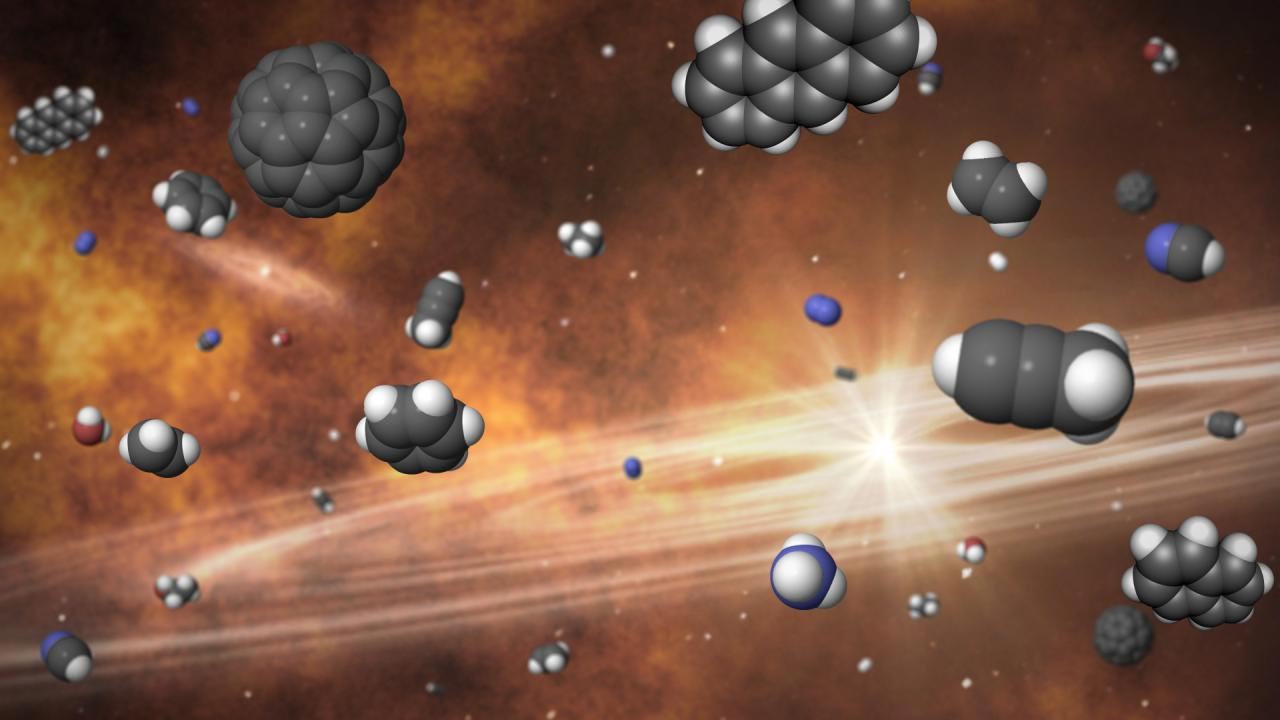Композиция на художник от „супа“ от пребиотични частици около протопланетен диск. Кредит: Габриел Перес Диас (IAC)
Проучване, проведено от изследователя Сузана Иглесиас от Космическия астрономически институт на Канарските острови, разкрива наличието на големи количества сложни органични молекули в един от най-близките региони на звездообразуване до Слънчевата система. Резултатите от това са публикувани в списанието Месечни известия на Кралското астрономическо дружество.
Учените Сузане Иглесиас-Грот от Астрономическия институт на Канарските острови (IAC) и Мартина Марин-Добреник от Политехническия университет в Картахена откриха няколко пребиотични молекули в звездообразуващия регион IC348 на молекулярния облак Персей, млад звезден куп на възраст около 2-3 милиона години.
Някои от тези биологични молекули са основните градивни елементи за изграждане на по-сложни молекули, като напр[{“ attribute=““>amino acids, which formed the genetic code of ancient micro-organisms, and brought about the flourishing of life on Earth. Getting to know the distribution and the abundances of these precursor molecules in regions where planets are very probably forming, is an important challenge for astrophysics.
The Perseus Cloud is one of the star-forming regions closest to the Solar System. Many of its stars are young, and have protoplanetary discs where the physical processes which give rise to planets can take place. “It is an extraordinary laboratory of organic chemistry” explains Iglesias-Groth who in 2019 found fullerenes in the same cloud. These are complex molecules of pure carbon that often occur as building blocks for the key molecules of life.
Now new research has detected in the inner part of this region common molecules such as molecular hydrogen (H2), hydroxyl (OH), water (H2O), carbon dioxide (CO2) and ammonia (NH3) as well as several carbon-bearing molecules which could play an important role in the production of more complex hydrocarbons and prebiotic molecules, such as hydrogen cyanide (HCN), acetylene (C2H2), diacetylene (C4H2), cyanoacetylene (HC3N), cyanobutadiyne (HC5N), ethane (C2H6), hexatriyne (C6H2) and benzene (C6H6).
The data also show the presence of more complex molecules such as the polycyclic aromatic hydrocarbons (PAH) and the fullerenes C60 and C70. “IC 348 seems to be very rich and diverse in its molecular content” states Iglesias-Gorth. “The novelty is that we see the molecules in the diffuse gas from which stars and protoplanetary discs are forming.”
The presence of prebiotic molecules at interstellar sites so close to star clusters suggests the possibility that accretion processes are taking place on young planets which could contribute to the formation of complex organic molecules. These key molecules could have been supplied to the nascent planets in the protoplanetary discs and could in this way help to produce there a route towards the molecules of life” stresses Marina-Dobrincic.
The detection by the two researchers is based on data taken with NASA’s Spitzer satellite. The next step will be to use the powerful James Webb Space Telescope (JWST). “The spectroscopic capacity of the JWST could provide details about the spatial distribution of all these molecules, and extend the present search to others which are more complex, giving higher sensitivity and resolution which are essential to confirm the very probable presence of amino acids in the gas in this and in other star-forming regions” concludes Iglesias-Groth.
Reference: “A rich molecular chemistry in the gas of the IC 348 star cluster of the Perseus Molecular Cloud” by Susana Iglesias-Groth and Martina Marin-Dobrincic, 16 March 2023, Monthly Notices of the Royal Astronomical Society.
DOI: 10.1093/mnras/stad495

„Тотален фен на Twitter. Нежно очарователен почитател на бекона. Сертифициран специалист по интернет.“







More Stories
Изследователите са открили начин да огъват светлината около ъглите и е лудост да го видим в действие
Тази зашеметяваща снимка на лице на мравка изглежда като нещо от кошмар: ScienceAlert
SpaceX изстреля 23 сателита Starlink от Флорида (видео и снимки)